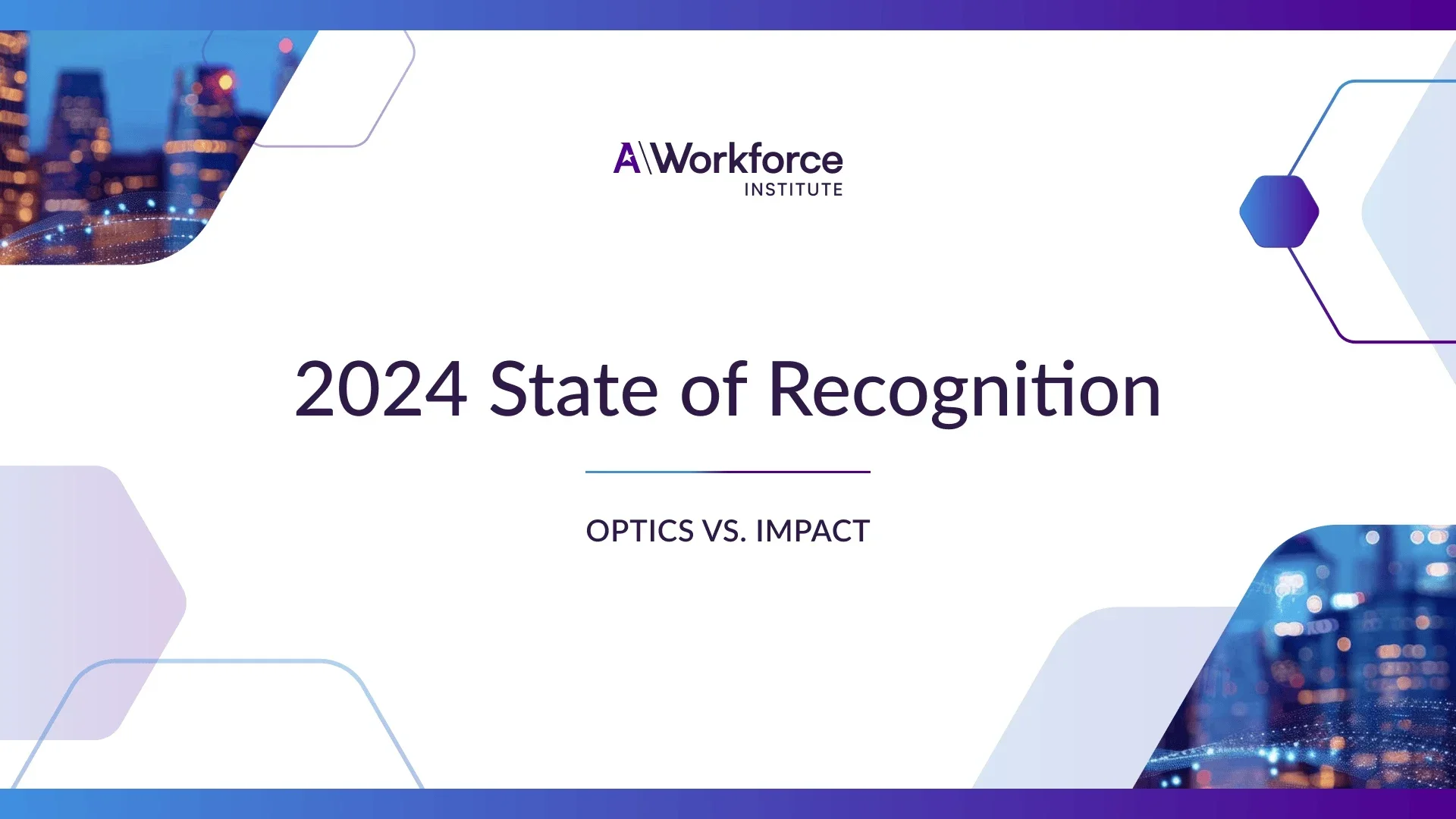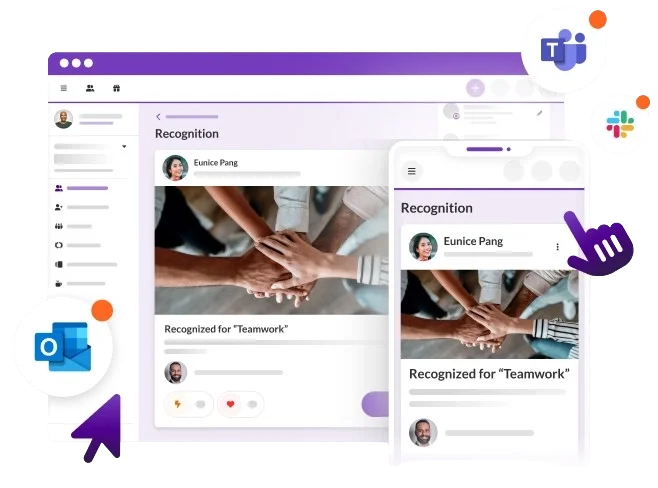Table of contents
In today’s workplace, employee recognition is more than just a nice-to-have — it’s a key driver of productivity, engagement, and retention. As organizations continue to face the ongoing challenge of attracting and retaining top talent, knowing the true impact of employee recognition programs is essential.
However, to make well-informed decisions, HR leaders need more than anecdotal evidence — this is where data and statistics come into play.
For example, a Sirota Consulting survey reveals that only 51% of employees feel satisfied with the recognition they’re given for a job well done. This suggests that managers may be overlooking the importance of expressing appreciation or failing to deliver it in a way that resonates with employees. Statistics like this can provide valuable insights while guiding HR practitioners in coaching managers to improve their approach to employee recognition.
Armed with the latest data on employee recognition, organizations can gain valuable insight into what motivates their workforce and optimize recognition strategies, ultimately creating a culture where employees are at their most productive and engaged.
Insights and trends
Achievers Workforce Institute’s 2024 State of Recognition report reveals key trends and insights that are reshaping modern workplaces.
Peer-to-peer recognition is increasingly popular, promoting inclusivity and collaboration within teams. The report shows that employees who receive recognition at least monthly are twice as likely to feel connected to their coworkers, experience a culture of trust, and have a strong sense of belonging within their organization.
Besides peer recognition, another key trend is the growing role of recognition platforms in providing real-time feedback and rewards. Research shows that employees with access to a comprehensive rewards marketplace are 60% more likely to feel meaningfully recognized at work and 61% more likely to experience a strong sense of belonging.
As organizations adapt to the ever-evolving expectations of their workforce, insights and trends like these underscore the critical role well-executed employee recognition programs play in boosting engagement, productivity, and overall business success.
20 employee recognition statistics that prove its effectiveness
From the strong correlation between recognition and increased productivity to its role in boosting employee engagement and retention, these insights will help you understand why recognition is a crucial component of any effective HR strategy.
Statistics that show the impact recognition has on productivity
1. Increasing recognition from quarterly to monthly boosts the likelihood of engagement and productivity by 40% and job commitment by 25%.
According to research from Achievers, recognition is a crucial protective factor. Employees that receive recognition monthly or more are three times more likely to be productive, engaged, and loyal to their organizations — compared with those not recognized.
In addition, the report notes that employees who receive monthly vs. quarterly recognition are 36% more likely to say they are productive and engaged and 22% more likely to be committed to their jobs.
2. Doubling weekly employee recognition leads to a 24% improvement in quality, 27% less absenteeism, and a 10% reduction in shrinkage.
According to Gallup’s State of the American Workforce Report, only 3 in 10 employees strongly agree that they have received praise or recognition for a job well done within the past seven days. However, the report reveals that if organizations double that ratio to six in 10 employees, they may see a substantial boost in work quality, decrease in absenteeism and shrinkage.
Top performers are difficult to replace, so leaders must prioritize making them feel appreciated and valued to avoid losing them. Employees who don’t feel recognized are twice as likely to consider leaving within a year, making recognition an essential element of any retention strategy.
3. Employees that are recognized monthly are 36% more likely to say they are productive and engaged, and 22% more likely to be highly committed to their roles.
Research shows that recognition has a safeguarding effect against turnover, and increasing the frequency of recognition has big benefits to employee productivity. In fact, our 2023 State of Recognition Report reveals that employees that are recognized monthly are more likely to feel productive and engaged, compared with those that are recognized on a quarterly basis.
There are even more benefits if companies want to increase the frequency of recognitions to weekly. Research shows that employees recognized weekly are “three times more likely to say they are engaged, productive, and committed to their job – compared to those never recognized.”
4. A thoughtfully designed recognition and rewards program can boost average employee performance by 11.1%.
Turns out, recognition has the power to influence employee performance, and it can go beyond simply praise for a job well done. A recognition and rewards program tailored to employee needs and preferences can boost performance.
In fact, a points-based recognition program connected to a diverse rewards marketplace can effectively create an environment where employees feel valued and motivated to go the extra mile.
Statistics that show the impact recognition has on engagement
5. Employees who say their managers excel at giving positive recognition are 40% more engaged than those whose managers don’t provide the same level of praise.
According to Harvard Business Review, recognition is key to keeping employees engaged, productive, and ultimately loyal to your organization. In fact, employees with managers who excel at giving positive recognition were substantially more engaged than those who weren’t recognized in the same way.
In addition, employees who receive strong recognition from their managers tend to have higher confidence, are top performers, and are less likely to leave their jobs.
6. Employees who expect to be recognized are 2.7 times more likely to be engaged.
Research shows that recognition is a powerful way to give feedback and is crucial to boosting employee engagement. In fact, Quantum Workplace shows that employees are 2.7 times more likely to be highly engaged when they expect recognition from leadership.
Employee engagement is influenced by several factors, such as leadership prioritizing employees as their most valuable resource, ensuring recognition for their contributions, and providing clarity on how their work connects to the organization’s objectives.
7. 90% of employees say that receiving recognition for their work motivates them to put in more effort.
According to an Achievers Engagement and Retention Report, recognizing employees for a job well done reinforces behaviors that align with company goals and culture, leading to increased engagement and a greater willingness to go the extra mile.
This leads to a positive feedback loop, as what gets recognized, gets repeated. To this point, the report also highlights that 92% of surveyed employees say that they’re more likely to repeat a specific action that they were recognized for.
8. 55% of employee engagement is driven by nonfinancial recognition.
According to McKinsey & Company, employees that feel undervalued are disengaged and often choose to leave their roles. Efforts such as offering a uniform, one-time bonus, could come across impersonal and transactional. At the surface level, it may seem generous – but McKinsey points out that bonuses (and other financial forms of recognition) risk being ineffective as they fail to resonate on a deeper level.
Instead, organizations could focus on creating personalized and meaningful recognition experiences. One way could be by establishing peer-to-peer recognition programs where employees can recognize each other for a job well done through notes, emails, or nominations for spot bonuses.
9. 74% of employees who are recognized for a job well done also strongly agreed that they believe their work is useful and valuable.
Research from Gallup reveals that almost three-fourths of U.S.-based employees who were on teams that received praise felt their work was meaningful and purposeful.
Recognition reinforces a team’s sense of purpose by demonstrating the impact of their work. By acknowledging their contributions, it boosts motivation, which ultimately elevates team-wide engagement.
10. 38% of Gen Z employees prefer to be recognized several times a week or more, requiring more recognition than older workers.
Gallup reveals that younger workers want to be recognized a few times a week or more. However, only a quarter of them are being recognized at that frequency. This is in comparison to the older generation, where 25% of Millennials, 17% of Gen X employees, and only 16% of Baby Boomers would desire recognition at the same frequency.
By giving younger employees the recognition they need to succeed, employers can reinforce quality work early on and will be able to nurture confident, engaged team members who contribute to organizational success for years to come.
Statistics that show the impact recognition has on retention
11. Employees who feel insufficiently recognized are twice as likely to say that they’ll leave their jobs this year.
Research from Gallup shows that there’s a link between inadequate or infrequent recognition and the likelihood of turnover. It turns out that showing appreciation for a job well done may be one of the keys to retention, as recognition can make employees feel valued while boosting productivity and loyalty.
However, Gallup also reveals that only one-third of workers in the US strongly agree that they’ve been recognized or praised for the good work they do within the past week – so there’s some room for improvement in this area.
12. Employees who report that they are never recognized are 39% more likely to say they will job hunt.
According to the Achievers 2023 Engagement and Retention Report, employees who say they’re never recognized are 39% more likely to look for a new job. This highlights the importance of recognition in reducing turnover. When employees feel valued, they’re less likely to job hunt.
To boost recognition, employers can educate their teams on its impact, launch top-down recognition campaigns, and invest in an optimized platform that encourages regular recognition—helping create a positive, engaged work culture and improving retention.
13. 88% of employees say that recognition increases their likelihood to stay with the company and as well as refer others.
Research from AWI shows that incorporating diversity and inclusion (D&I) into recognition programs makes most surveyed employees feel more engaged, productive, creative, satisfied, and innovative. It also boosts their sense of belonging and connection to their team. All the above positive sentiments make employees more likely to stay loyal to the organization and, on top of that, make referrals as well.
To put this into perspective, companies that don’t link their D&I and recognition programs have just 54% of employees agreeing with the above statements.
14. 45% of employees who feel meaningfully recognized feel more connected, and employees with a strong sense of connection are 19% less likely to job hunt.
AWI’s 2023 Engagement and Retention report reveals that the top driver of connection is recognition, with almost half of surveyed employees saying that they feel more connected with others at work if they’re meaningfully recognized.
The report also shows that the more often an employee is recognized, their feeling of connection also rises. In fact, 53% of employees that are recognized weekly say that they feel a “strong connection with peers and colleagues.” This is compared with just 30% who are recognized monthly, and 18% that are recognized on a quarterly basis.
15. 53% of employees who left their jobs say that a lack of recognition was a key reason for their departure.
According to Quantum Workplace, turnover is predictable and preventable, and feeling unappreciated for their work is one of the top reasons that employees leave their jobs.
To reduce the risk of employees feeling unappreciated and leaving the organization, it’s crucial to engage in conversations about career advancement and their future with the company. A significant 70% of employees who left their jobs reported not having discussed their growth opportunities or prospects several months before their departure. Providing these discussions could potentially help retain employees by addressing their career aspirations and concerns.
Comparing employee recognition across countries
By exploring how recognition is carried out in the U.S. compared to international counterparts, organizations can gain valuable insights into global best practices and tailor their strategies to create more inclusive and effective programs.
16. 89% of North American organizations have an employee recognition program, compared with 68% in Asia and 65% in Europe.
A survey by SHRM highlights that employee recognition programs are more common in the U.S. compared with other countries. However, this is not necessarily an indicator that organizations in Asia and Europe aren’t as recognition-savvy, as there may just be cultural differences at play.
For instance, organizations in Latin America take a more personalized and informal approach to recognition, where managers and colleagues show their appreciation through small gifts and other thoughtful gestures. Meanwhile in Japan, the practice of “mochi-age” involves recognizing employees that have reached certain milestones or accomplishments.
17. 60% of Americans feel meaningfully recognized at work, compared with the global average of 52%.
According to an AWI 2024 report on recognition where 3,600 employees across the U.S., the U.K., Canada, and Australia were surveyed, workers in the U.S are recognized more frequently and meaningfully. 27% say that they feel meaningfully recognized, which is compared with the global average of 19%.
To add, 69% of Americans say that they have an online recognition solution, compared with the global average of 61%.
Cultural differences in recognition practices
Singapore recognition statistics
18. 32% of Singapore employees cite not feeling valued, appreciated, or recognised as the main reason they consider leaving their current employer.
A recent report from Ipsos shows that 32% of employees in Singapore are thinking about leaving their jobs because they don’t feel valued, appreciated, or recognized. This underscores how important recognition is for keeping talent. Along with factors like low motivation and the search for better career opportunities, a lack of recognition is a major reason employees consider moving on, with pay and benefits still being the top reasons across all groups.
Australia recognition statistics
19. 52% of Australia-based employees are recognized monthly at work, but only 15% of Australians feel meaningfully recognized.
According to AWI’s 2024 State of Recognition report, there’s a discrepancy between the recognition that Australian employees receive and their feelings about whether the recognition was meaningful to them. In comparison to the global average of 19%, only 15% of Australians feel meaningfully recognized.
This shows the need for organizations to focus on quality over quantity when it comes to recognition. Ensuring recognition is personalized and tied to specific achievements can help bridge this gap, creating a stronger sense of appreciation among employees.
20. 60% of Australia-based employees say that their recognition program helps build culture.
According to the same above AWI report, more than half of surveyed Australians feel that their recognition program helps with fostering company culture (5% higher than the global average of 55%). However, 30% of Australians say that their recognitions programs are not points-based, and they’re unable to give or receive points within those platforms.
By introducing point-based systems and encouraging employees to recognize each other, companies can boost engagement and build a more inclusive workplace culture. Taking into account the unique ways Australians value recognition can make these programs even more impactful.
Get help with measuring employee recognition with statistics
The statistics that we’ve shared in this article underscore the crucial role that recognition plays in overall employee job satisfaction, so understanding how to implement a successful recognition strategy is key to promoting organizational growth, health, and long-term success.
Achievers’ powerful employee recognition platform equips HR leaders with a suite of recognition tools to measure, track, and report on the success of your program. In fact, our customers have reported significant business improvements including decreased voluntary turnover and improved workplace safety.
Discover Achievers Recognize and elevate your company culture with high-impact, frequent recognition.



Key insights
- Regular employee recognition — especially monthly or more frequent — significantly boosts engagement, productivity, and retention, with recognized employees being three times more likely to excel in these areas.
- Peer-to-peer recognition and diverse rewards marketplaces are transformative trends, fostering inclusivity, belonging, and motivation in modern workplaces.
- Inadequate or infrequent recognition doubles the likelihood of employee turnover, underscoring its critical role in retention and overall organizational success.
